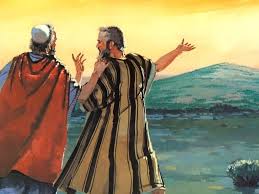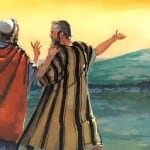The 9th day of the Jewish month of Av, Tisha b’Av, is a day that exemplifies sadness. It is a time appointed for sad things to possibly occur .Time in essence is not running along a linear path .The Torah view of the world views specific dates and appointed times are gates through which time flows in a cyclical and upward spiral fashion. Those times affect and spark either spiritual turmoil or yearning and growth.
Tisha B’av is one of those times.
At the borders of the biblical land of Israel Moshe wanted the twelve scouts to explore the land reveal its greatness and bring back tidings of its promise. Ten of these men did not have the vision to do that. All they saw was their own unworthiness.
“And there we saw the Nephilim, the sons of Anak, who come of the Nephilim; and we were in our own sight as grasshoppers, and so we were in their sight.” (Numbers 13:33)
All that they were able to see were their own fears and insecurities;
In the Torah portion of Devarim preceeding TishaB’Av, the issue of seeing and faulty vision become a central theme
Hashem, your God, Who goes before you He will fight for you, just as He did for you in Egypt before your very eyes, ( Deuteronomy 1:30).
Seeing G-d’s hand in this world becomes necessary in order to become part in the unfolding plan of destiny.
It is not happenstance then that the Shabbat before the ninth of Av is called Shabbat Chazon- the “Shabbat of Vision”. The fast day of Tisha b’Av which was impacted by the Sin of the Spies, commemorates a whole tragic litany of difficult and painful events in Jewish history including the destruction of both temples. On Shabbat Chazon we read the Haftara portion from the prophecies of Isaiah (1:1-27). This haftara is the final of the “three of readings of affliction,” The reading begins with the words;
”The vision (Chazon) of Isaiah the son of Amoz, which he saw concerning Judah and Jerusalem.“ (Isaiah 1:1)
Yet verses in these prophetic words of isaiah are not only a description of the vision of what went wrong and how unworthy we were. It is more a vision of what we could be and what we truly can achieve in our journey’s mission. It is all about what type of “eyes” we look with .Just as important , it is about the question ;do we take the time to truly see.
The scroll of EICHA ( lamentations read on Tisha b’Av) is written as an acrostic, following the Alef-Bet format What is most noteworthy is that there are a few places wherein the verses divert from this Alef Bet format. More specifically, in the second, third and fourth chapters, the sentences beginning with the letters “Ayin” and “Peh” are written out of order. In the Hebrew alphabet the letter “Ayin” precedes the letter “Peh”. In the case of Eicha the verses connected to the letter “Peh” precede those connected to the letter “Ayin”.
The word “Ayin” also means “eye” and the word Peh means “mouth”. The symbolism alluded to by Jeremiah the author of the book of Lamentations is that the sin of the spies was based on the fact that they spoke before “seeing” the full picture (Tractate Sanhedrin 104b ). That same dangerous tendency also led to the baseless hatred that brought about the destruction of the Temple. It also continues to be the source of mistrust suspicion and animosity amongst peoples, families and spouses.
The natural order necessitates, first seeing the whole picture before speaking of its dangers or opportunities .Only then can we truly understand the process of redemption the world is in the midst of. It is the lack of vision and our impaired ability to truly “see” that keeps blocking us from our goal.
The rebuilding of the Temple then is not only the goa lit is also the solution to a broken world. That is the source of the great yearning we are feeling in this time.
It is in that place that we would learn to truly see again. It was on that mount that the promise of that spiritual vision was first established and it will be on that mountain that it will be re-established, B’meHeira BeYameinu( speedily in our days).
“And Abraham called the name of that place Adonai-Yireh; as it is said to this day: ‘In the mount where Hashem is seen.’” (Genesis 22:14)
Le-Refuat Yehudit bat Golda Yocheved

